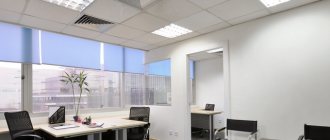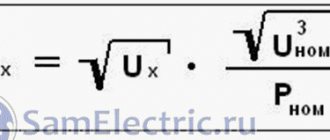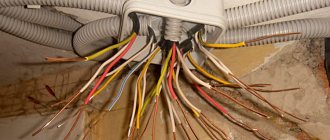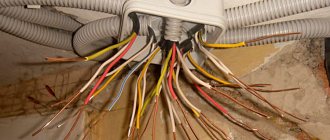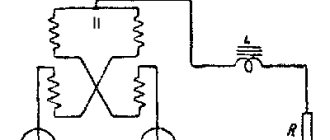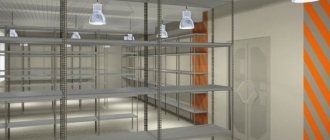04/12/2016 master
We all want to live in a beautiful and comfortable home, where every thing will be in its place. But for this it is necessary to take into account a wide variety of parameters: the color of the walls, the furniture used, and lighting. At the same time, it is the lighting in the house that plays a leading role in creating maximum comfort for a safe and convenient pastime in any living space.
This article will tell you what standards currently exist for residential premises in terms of their illumination, as well as why this needs to be taken into account.
Meaning of light
Human eye
Light has always been of great importance for people, since it is the visual analyzer that provides us with almost 90% of the information about the world around us. And in the conditions of computerization of society, not every person is able to maintain visual acuity at the proper level.
At the same time, you can significantly deteriorate your vision even without working at a computer for 8 hours a day. It is enough to make poor lighting in your home and you will be provided with a set of problems in just a couple of years. Just the right lighting, which is created in the house by various types of lighting fixtures, will allow you to increase your productivity, normalize the microclimate in the family and take a more effective break from work.
Directional light
Since we spend most of our time at home (of course, after work), we need to approach the lighting of the apartment as responsibly and thoughtfully as possible. After all, this is where no one can put you in to make your life better and more comfortable. Light in the house can be supplied as follows:
- directed. This lighting is created by ceiling chandeliers and wall sconces with floor lamps;
- scattered. Such light is possible from hidden backlights, which have recently become very popular. They look especially beautiful on plasterboard and suspended ceiling structures. Unlike directional lighting, diffuse lighting alone cannot independently provide the required level of light in the room. Therefore, it often acts as additional lighting.
Diffuse lighting
It is also worth noting that a room in the house such as the kitchen requires additional lighting in certain areas. It is with the kitchen that many people have problems in terms of creating proper lighting. This is due to the fact that the kitchen is often small in size and is always filled with all kinds of kitchen utensils, devices and cabinets. As a result, there are many dark and poorly lit areas. To help solve this problem:
- spotlights installed above the work area (countertop, sink, stove);
- LED cabinet lighting.
But in any case, before installing certain lighting fixtures, you need to find out what degree of illumination you need. For these purposes, you should seek help from SNiP.
Units of measurement and lamp table
The physical concept of illumination is used as the main indicator for measuring the amount of light in a room. The unit of measurement for luminous flux is lux. 1 lux is equal to a luminous flux of 1 lumen, which falls on 1 square meter of area. Different lamps generate different amounts of illumination; In the table below you can find out how many lux different lamps generate:
| Power of a standard incandescent lamp | Fluorescent lamp power | LED lamp power | The luminous flux generated by the lamp |
| 20 W | 5 - 7 W | 2 - 3 W | approximately 250 lux. |
| 40 W | 10 - 13 W | 4 - 5 W | approximately 400 lux. |
| 60 W | 15 - 16 W | 8 - 10 W | approximately 700 lux. |
| 75 W | 18 - 20 W | 10 - 12 W | approximately 900 lux. |
| 100 W | 25 - 30 W | 12 - 15 W | approximately 1200 lux. |
| 150 W | 40 - 50 W | 18 - 20 W | approximately 1800 lux. |
| 200 W | 60 - 80 W | 25 - 30 W | approximately 2500 lux. |
Effect of light
Natural lighting is considered the best type of residential lighting today. Therefore, the residential complex is characterized by large window openings, which adequately provide illumination of the interior during the day. But natural light is only possible during daylight hours. In addition, the layout of the premises does not always allow sunlight to be illuminated at the required level even during the day. Therefore, artificial lighting is always used for any living space, which is an excellent alternative to natural light.
Note! Using natural lighting in rooms is the most optimal option for the human visual system. This is due to the evolutionary development of human vision, which over a long period of its history used only natural light.
Daylight
It is very important that the artificial lighting of the interior space is as close as possible in its technical parameters to natural lighting. Otherwise, if they spend a long time in a room with improperly designed light, people will begin to experience discomfort and the following negative effects:
- headaches appear, even migraines;
- irritability increases;
- performance decreases;
- skin diseases may develop;
- Visual acuity begins to decrease. At the same time, the eyes will become tired, watery and red faster;
- You may have trouble sleeping;
- in rare cases, there is a decrease in appetite;
- the risk of exacerbation of chronic diseases, as well as respiratory diseases, increases due to a general decrease in immunity.
As you can see, incorrectly selected lighting for a room where the standards given in SNiP (special documentation - building codes and regulations) have not been met will have an extremely negative impact on well-being. It is worth noting that the most striking and early-onset consequences of disturbances in the functioning of the body will be noticeable in children. In the case of children, pathological disorders can even become irreversible. Therefore, we can conclude that light in our lives, especially artificial light, plays a very important role and directly affects our health. Moreover, both physically and mentally.
Final provisions
Perhaps today there is not a single municipality that could comply with all the requirements of numerous sanitary rules and regulations in its premises. Delving into the established requirements even according to one of the criteria, as in our case for the coverage of MO, you understand that a lot of difficulties arise not only with fulfilling the requirements, but, first of all, with understanding them. As mentioned earlier, the main problem of the domestic system of sanitary rules and norms is their excessive number, a huge number of norms to others, as well as the presence of existing sanitary rules that were developed and approved back in the days of the USSR. All this complicates their understanding and application of ML. This problem was partially solved due to the introduction of the “regulatory guillotine” and the updating of SanPinov for medical organizations. But, alas, it cannot be called completely resolved (in particular, the set of rules for design and construction remained untouched)
The problem of complying with sanitary requirements is, as one might put it, a “double-edged sword.” On the one hand, the designed modern MOs, or those MOs in which a thorough reconstruction is being carried out, simply cannot be guided in the process of their creation by outdated norms from the Soviet period. On the other hand, we all know that in various regions of our vast country, the buildings of hundreds of medical institutions have a year of construction that is several decades old, and many of these buildings and premises are in deplorable condition. For such municipalities, it is simply technically impossible to meet modern sanitary requirements, not to mention the financial side of the issue. For such MOs, it is probably more convenient to be guided and comply with the rules put into effect during the Soviet era, since these rules were developed precisely in the very era when their buildings were built. Therefore, almost any inspection conducted by supervisory authorities for compliance with sanitary rules and regulations ends with the identification of violations and holding the Ministry of Defense or its officials accountable. And this is typical not only for private medicine, but also for state (or municipal) medical organizations. The reason for non-compliance with all sanitary requirements established by the legislator is banal and lies not so much in the reluctance of the leadership of the municipality to comply with them, and, especially, not in the negligence of the medical staff, but in the lack of funding from the state to equip state and municipal municipalities with everything necessary that is required by the norms of the current sanitary legal acts.
Features of the premises
When taking into account such a parameter as lighting standards, it is necessary to remember that they are different for different residential premises. In SNiP you will find standards for the level of illumination for both non-residential and residential rooms.
Table from SNiP
As can be seen from the table above, for non-residential and residential premises these indicators vary within fairly wide ranges. Moreover, if everything is more or less clear with non-residential rooms, then with the residential segment you will need to tinker. This is due to the fact that people will spend more free time here, which already imposes certain limits that should correspond to a comfortable and safe pastime. Therefore, SNiP has different standards for each individual room:
- living room;
- bedroom;
- study;
- kitchen;
- children's room;
- corridor;
- bathroom.
This difference is primarily due to the fact that each room has its own purpose and people spend different amounts of time in them. The most visited rooms in the house are the kitchen and living room. After them there are bedrooms, a bathroom and a corridor. Therefore, the calculation of the level of lighting that will need to be created for a specific room must be approached very carefully and responsibly.
A course to improve air purity
Production capacity is constantly growing across the planet, which means air pollution is increasing. The only way out of this situation is the parallel modernization of enterprises and the improvement of technologies and measures for cleaning the air basin.
We advise you to study Biogas - composition and raw materials for production
It is important to remember that improving air filtering devices is not a panacea for all the ills of dust pollution. One measure is not enough - the approach must be comprehensive. For example, it is necessary to seal all equipment, introduce remote control methods, replace dry production processes with wet ones and, of course, constantly carry out vacuum cleaning
For example, it is necessary to seal all equipment, introduce remote control methods, replace dry production processes with wet ones and, of course, constantly carry out vacuum cleaning.
The ideal means of combating dust is the introduction of closed air cycles, which allow creating waste-free production. In this case, harmful emissions do not penetrate into the environment, but are collected for further beneficial use. The possibility of using this technology is available in almost all types of production.
Artificial light
Full lighting
Today, natural lighting alone is not enough. This is the objective reality of our time. Humanity is increasingly leading an evening or nocturnal lifestyle. This is due to the fact that most of the daylight hours we are at work, while only evenings and weekends are left for family and recreation. Therefore, in order for your vacation to be complete, and communication with family and friends to bring only positive emotions, you need to make sure that optimal lighting is created in your home.
A distinctive feature of artificial lighting is the ability for a person to independently control the level of light available in each room of the house. Artificial lighting for a residential building can be created by the following types of lighting devices:
- ceiling lamps. Most often, their role is played by either one large chandelier or many spotlights;
- wall sconces;
- table lamps;
- floor lamps.
In one room, in order to comply with SNiP standards, you can use all types of lighting at once or combine only some options.
Note! For apartments and houses, the optimal choice in terms of room illumination is a combination of several options.
Thanks to the excellent range of lighting products on the market, you can use a wide variety of light sources to illuminate your home.
Sources of light
- incandescent lamps. It is for these light sources that SNiP provides basic standards (most values). Therefore, if you use other light bulbs, then you will need to make a small recalculation for the selected light source;
- halogen and metal halide lamps;
- fluorescent light bulbs;
- gas discharge lamps;
- LED
Each of the above light sources has both pros and cons. Therefore, be very careful when choosing light bulbs for your home, as not all lamps will give you the required level of illumination. All of the light sources listed above, except the incandescent light bulb, are energy-saving. Today, LED models are the undoubted leader, as they are the most economical in terms of energy consumption and have a long service life. But their disadvantage is their fairly high cost.
What we take into account
When determining the norm for the degree of illumination according to SNiP, the light source is the second most important aspect (after the purpose of the room). In order not to make a mistake and make the right choice, you need to take into account the following parameters in which different types of lamps differ from each other:
- power. This parameter represents the value that a particular light source consumes when operating. Measured in Watts;
- Colorful temperature. Determines the tone of the resulting lighting. Located in the range between cold and warm light. Measured in Kelvin. Warm shades are considered the most optimal for vision;
Colorful temperature
- light flow. This parameter reflects how much light was emitted by the light bulb. Measured in Lumens;
Note! This indicator should be as close as possible to natural lighting. Same as color temperature.
- voltage.
Measured in Watts. As a rule, light bulbs with voltages of 12 and 220 V are used. Lamp option
In addition, it is necessary to remember that the base of the light source must coincide with the socket of the lighting fixture. This is where many people get screwed by buying economical light bulbs that are not suitable for their chandeliers or sconces.
Note! The dimensions of the purchased light bulb must match the dimensions of the existing lighting fixture.
In addition, important parameters are:
- installation location;
- height from the floor;
- type of lampshades (matte or transparent);
- angle of direction of the light flux.
Just based on these parameters alone, it becomes clear how different the lighting created in a living space can be. By changing one or another parameter, you can independently regulate the degree of lighting in the room. For example, installing a ceiling light with clear shades will give you much more light.
Lighting recommendations
There are several general recommendations for creating comfortable electric lighting:
It is better to choose lighting design that matches the color of the interior. The distribution of luminous flux should be uniform in bright rooms. For dark ones, it is better to use zone lighting. Sudden changes in lighting should be minimized
Each piece of furniture should be illuminated evenly. Use lamps with a color temperature that is comfortable for the eyes. When selecting lamps, it is necessary to take into account the reflection coefficient from the floor, walls, ceiling and other objects.
The following rules are often followed based on the functionality of the premises:
- The hallway is in most cases deprived of natural electric lighting. For lighting, lamps with directional light and large dispersion angles are installed.
- The living room is a multifunctional room in which general lighting is often combined with spotlights to obtain maximum functionality.
- The kitchen-living room is divided into zones; general lighting is combined with spot lighting, which has an auxiliary function.
- Bedroom – used for rest and sleep. Calm, warm colors are recommended, with the ability to regulate the light intensity using dimmers.
- A bathroom is a room in which general lighting is combined with local lighting.
Documentation
The standards specified in SNiP were developed taking into account many indicators that can affect people’s performance and recreation. The required level of natural illumination of the premises was also taken into account. Ultimately, the values were obtained that are now included in SNiP. The SNiP rules clearly define the standards for the level of illumination for each room in a house or apartment.
SNiP standards for apartments
The standards in the documents are given in Lux, which reflects the available luminous flux per square meter of the room. It is worth noting that SNiP provides minimum indicators for premises, so their slight variation is allowed within a small range. According to SNiP for a home, the minimum illumination level should be 150 Lux. Further, depending on the purpose of the room, this parameter can be increased. For example, for a children's room you should create lighting at a level of 200 Lux, and for a study you will need 300 Lux. The light level parameters given in these documents will allow you to create comfortable conditions in your home for communication, relaxation or work. Therefore, they must be followed when decorating an apartment.
Luxmeter to help
Luxmeter
To make sure that there is the required level of light in the room, you can use a device specially designed for this purpose - a lux meter. With its help, you can quickly and without any problems measure the degree of illumination of each corner in the room and you can make sure that there is enough light here for a normal pastime and maintaining good health.
Lighting standards established for residential premises should be approximately the same level during the day and at night.
Usage rate
The essence of the method is to use the coefficient η. This coefficient is equal to the ratio of the luminous flux incident on the surface to the total luminous flux coming from the lighting device.
In our case, “i” is calculated as follows i=(B+A)/h*(A+B), where:
- B – width;
- A – length;
- h – design height.
In addition, you need to calculate the luminous flux for each working lamp. The calculation is carried out using the following formula
Where:
- E – specified level of minimum illumination;
- K – standard safety factor;
- S – area illuminated by the lamp;
- z – coefficient reflecting the unevenness of illumination;
- N is the number of lamps installed in the room. This parameter must be determined in advance before calculations.
Using this method, you can easily calculate the luminous flux for each lighting fixture that will be used indoors.
What influences
In addition to the factors listed above, the level of illumination in rooms can be influenced by the following nuances:
- room dimensions;
- color scheme used for interior decoration of the room. With light colors, the level of light reflection will be higher and, accordingly, the lighting required here will not be as intense. But if the floor and walls are painted in dark colors, then the light in such a room will need a little more to comply with the standards prescribed in SNiP;
Room interior
- window opening sizes;
- color and type of fabric used for curtains and drapes. Today, many people are moving away from outdated curtains in favor of modern blinds.
It’s hard to imagine how much needs to be taken into account in order to properly and comfortably design the interior decoration of the rooms, and even to light it properly. But by spending time and energy on calculating the lighting standards for a specific room, you will ensure your health and good rest for many years to come.
Work area
Remember that you cannot illuminate only the workplace with a sufficient number of lamps, leaving everything else in twilight. The adjacent space must also meet certain lighting standards.
For example, what is located half a meter (0.5 m) from the workplace is called the immediate surrounding area.
Here are the recommendations for illumination values for this zone, according to GOST.
Everything further than 0.5 m from the workplace is a peripheral zone. In it, the illumination should be at least 30% of the previous zone within a radius of half a meter.
This is the only way you will create normal working conditions for yourself and your employees.
Important nuances
Lighting devices have long become an integral part of our daily lives. When organizing a technically and ergonomically correct artificial lighting system for a living space, the following recommendations should be taken into account:
- maximum uniform illumination of the entire room. The best option here would be to use spotlights located at equal intervals throughout the ceiling;
- absence of sudden changes in lighting and its pulsation;
- pleasant light emitted by the light source;
- absence of a state of “blindness” of the entering person;
- the spectrum of light emitted by the light bulbs is pleasant to the eye;
- optimal conditions for shadow formation;
- you need to take into account the light reflectance of all surfaces of the room - ceiling, walls and floor.
Lighting design
In order to take all this into account, it is necessary to carry out qualified design for each room in the house. There are many programs for these purposes. You can also seek help from specialists in designing light levels for residential premises.
What is the standard illumination for objects for various purposes?
Streets, roads and squares
| Illuminated objects | Average illumination, Lux (not less) |
| Highways, federal and transit routes. Road class - A | |
| A1 Highways, federal and transit routes, main city highways (outside the city center) - with a throughput capacity of more than 10,000 units/hour | 30 Lux |
| A2 Other federal roads and main streets (outside the city center) - with a throughput capacity of 7,000 - 9,000 units/hour | 20 Lux |
| A3 Central highways connecting streets with access to the A1 highway (in the city center) - with a capacity of 4,000 - 7,000 units/hour | 20 Lux |
| A4 Main historical passages of the center, internal connections of the city (in the city center) - with a throughput of 3,000 - 5,000 units / hour | 20 Lux |
| Main roads and district streets. Road class - B | |
| B1 Main roads and city streets (outside the city center) - with a throughput capacity of 3,000 - 5,000 units/hour | 20 Lux |
| B2 Main roads and city streets (in the city center) - with a throughput capacity of 2,000 - 5,000 units/hour | 15 Lux |
| Local streets and roads. Road class - B | |
| B1 Transport and pedestrian connections within residential areas and access to the city on the highway, except for streets with continuous traffic - with a throughput of 1,500 - 3,000 units / hour | 15 Lux |
| B2 Transport and pedestrian connections in residential neighborhoods and access to highways (residential developments in the city center) - with a throughput capacity of 1,500 - 3,000 units/hour | 10 Lux |
| B3 Transport connections within production and utility storage areas - with a throughput capacity of 500 - 2,000 units/h | 6 Lux |
Gas stations (gas stations) and parking lots
| Illuminated objects | Average illumination, Lux (not less) |
| Gas stations | |
| Places for refueling and discharging petroleum products | 20 Lux |
| Access roads from roads of category A and B | 15 Lux |
| Access roads from category B roads | 10 Lux |
| The rest of the gas station area, which has a roadway | 10 Lux |
| Parking lots and storage areas for rolling stock | |
| Open parking on streets of all categories and neighborhoods | 6 Lux |
Pedestrian spaces
| Illuminated objects | Average illumination, Lux (not less) |
| P1 Areas in front of the entrances of cultural, sports, entertainment and shopping facilities | 20 Lux |
| P2 Main pedestrian streets of the historical part of the city and main public centers, impassable and in front of factory squares, children's, landing areas, recreation areas | 10 Lux |
| P3 Pedestrian streets, main and auxiliary entrances to parks, exhibitions, stadiums | 6 Lux |
| P4 Sidewalks separated from the roadway, main passages of microdistricts, entrances, passages and central alleys of children's and educational institutions | 4 Lux |
| P5 Secondary passages in microdistricts, utility areas, side alleys, utility entrances | 2 Lux |
| P6 Side alleys and auxiliary entrances of parks of administrative districts | 1 Lx |
Underground and overground pedestrian crossings
| Illuminated objects | Average illumination, Lux (not less) |
| Passages of underground pedestrian crossings and tunnels | 75 Lux |
| Overhead pedestrian crossing passages with transparent walls and ceiling | 75 Lux |
| Staircases, ramps and viewing platforms for elevated pedestrian crossings with transparent walls and ceilings | 50 Lx |
| Stairs and ramps of underground pedestrian crossings and tunnels | 45 Lux |
| Open footbridges | 10 Lux |
Evacuation routes
| Illuminated objects | Average illumination, Lux (not less) |
| Evacuation routes for high-risk areas | 15 Lux |
| Escape routes up to 2 meters wide | 1 Lx |
| Evacuation lighting for large areas | 0.5 Lux |
